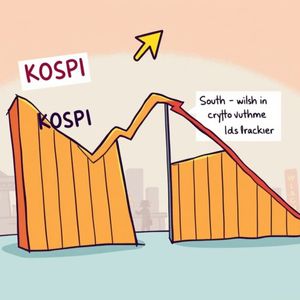
BitcoinWorld South Korea Crypto Trading Volume Plummets: A Stark Contrast to KOSPI’s Soaring Success A fascinating divergence is currently unfolding in South Korea’s financial landscape. While the nation’s main stock index, the KOSPI, has experienced an impressive surge in activity, the South Korea crypto trading volume has witnessed a significant contraction. This stark contrast prompts a closer look at the forces shaping investor behavior in one of Asia’s most dynamic markets. Unpacking the Decline in South Korea Crypto Trading Volume Recent reports highlight a dramatic shift in investor focus. According to data compiled by Maeil Business Newspaper, the trading volume on South Korea’s cryptocurrency exchanges has nearly halved since the beginning of the year. This decline stands in sharp relief against the performance of the KOSPI, which has seen its daily trading volume more than triple over the same period. Let’s break down the numbers to truly grasp the scale of this change: KOSPI’s Ascent: On November 3, the Korea Exchange reported that KOSPI’s daily trading volume reached an impressive 34.039 trillion won (approximately $24.67 billion). This marks a staggering 207.57% increase from the 11.0669 trillion won ($8.02 billion) recorded on January 2, the first trading day of the year. Crypto’s Contraction: In stark contrast, CoinGecko data for the same day (November 3) showed that the combined 24-hour trading volume for South Korea’s five largest cryptocurrency exchanges — Upbit, Bithumb, Coinone, Korbit, and Gopax — stood at just 5.5724 trillion won ($4.04 billion). This represents a substantial 44.93% decline over the same period. Currently, the combined crypto market’s trading volume is equivalent to a mere 16.37% of the KOSPI’s , underscoring a significant reallocation of capital and attention among South Korean investors. What’s Fueling KOSPI’s Remarkable Growth? The KOSPI’s robust performance can be attributed to several key factors that have bolstered investor confidence in traditional assets. A general improvement in economic sentiment, coupled with a focus on established companies, often drives capital towards the stock market. Investors may perceive traditional equities as a safer haven during periods of global economic uncertainty, offering more predictable returns and stability compared to the often-volatile crypto market. Moreover, corporate earnings, government stimulus measures, and a relatively stable regulatory environment often contribute to a thriving stock market. These elements collectively paint a picture of resilience and growth for South Korea’s conventional financial sector, drawing in both retail and institutional investors. Why Has South Korea Crypto Trading Volume Slowed Down? The notable decrease in South Korea crypto trading volume is likely a confluence of several factors, both local and global: Regulatory Scrutiny: South Korea has implemented stringent regulations on cryptocurrency exchanges and trading activities. While aimed at protecting investors and preventing illicit finance, these regulations can sometimes deter new entrants and reduce speculative trading, impacting overall volume. Post-Boom Correction: Following the exuberance of previous bull runs, the global crypto market has experienced a significant correction, often referred to as a ‘crypto winter.’ This period of lower prices and reduced investor enthusiasm naturally leads to decreased trading activity. Shift in Investor Preference: With KOSPI showing strong returns, many investors might be reallocating their capital from higher-risk digital assets to more established, liquid traditional markets. This reflects a broader shift towards perceived safety and stability. Lack of New Catalysts: A dearth of significant positive news or major technological breakthroughs in the short term can also contribute to lower engagement. Without strong catalysts, retail interest tends to wane. These challenges collectively paint a picture of a maturing yet currently subdued crypto market in South Korea. Navigating the Future: What’s Next for South Korea’s Crypto Market? While the current figures for South Korea crypto trading volume might seem discouraging, the long-term outlook for digital assets remains a topic of considerable debate and potential. The market is inherently cyclical, and periods of lower volume often precede new phases of growth driven by innovation, clearer regulatory frameworks, and renewed investor confidence. For investors, this period could represent an opportunity to: Re-evaluate Portfolios: Consider diversification strategies that balance traditional assets with a thoughtful allocation to digital assets. Focus on Fundamentals: Research projects with strong use cases and long-term viability, rather than purely speculative ventures. Stay Informed: Keep abreast of regulatory developments and technological advancements that could reshape the market. The future success of South Korea’s crypto market will likely depend on its ability to adapt to evolving regulations, foster innovation, and rebuild investor trust through transparency and robust security measures. The significant contrast between the KOSPI’s soaring success and the declining South Korea crypto trading volume offers a compelling snapshot of current market dynamics. It highlights a clear shift in investor sentiment, favoring traditional stability over the volatile allure of digital assets, at least for now. However, the crypto market is known for its resilience and capacity for rapid change. Understanding these trends is crucial for anyone navigating the complex world of finance in South Korea. Frequently Asked Questions (FAQs) 1. What is the main difference in trading volume between KOSPI and South Korea’s crypto market? Since the start of the year, KOSPI’s daily trading volume has more than tripled, reaching over 34 trillion won, while the combined daily trading volume for South Korea’s top five crypto exchanges has nearly halved, falling to about 5.5 trillion won on November 3rd. 2. What factors contributed to KOSPI’s significant increase? KOSPI’s growth is likely fueled by improved economic sentiment, investor confidence in traditional assets, potential corporate earnings, and a relatively stable regulatory environment for conventional finance. 3. Why has South Korea crypto trading volume decreased so dramatically? The decline is attributed to factors such as stringent local crypto regulations, a global ‘crypto winter’ leading to reduced investor enthusiasm, a shift in investor preference towards more stable traditional markets, and a lack of strong new catalysts in the crypto space. 4. Are these market trends unique to South Korea? While the specific figures are for South Korea, the general trend of traditional markets outperforming crypto during periods of economic uncertainty and regulatory shifts is observed in various global markets, though the extent may vary. 5. What does this mean for crypto investors in South Korea? It suggests a need for careful portfolio re-evaluation, a focus on the fundamentals of crypto projects, and staying informed about regulatory changes. It also highlights the importance of diversification between traditional and digital assets. Did you find this analysis insightful? Share your thoughts and help others understand the evolving financial landscape in South Korea by sharing this article on your social media! To learn more about the latest crypto market trends, explore our article on key developments shaping digital assets institutional adoption. This post South Korea Crypto Trading Volume Plummets: A Stark Contrast to KOSPI’s Soaring Success first appeared on BitcoinWorld .
